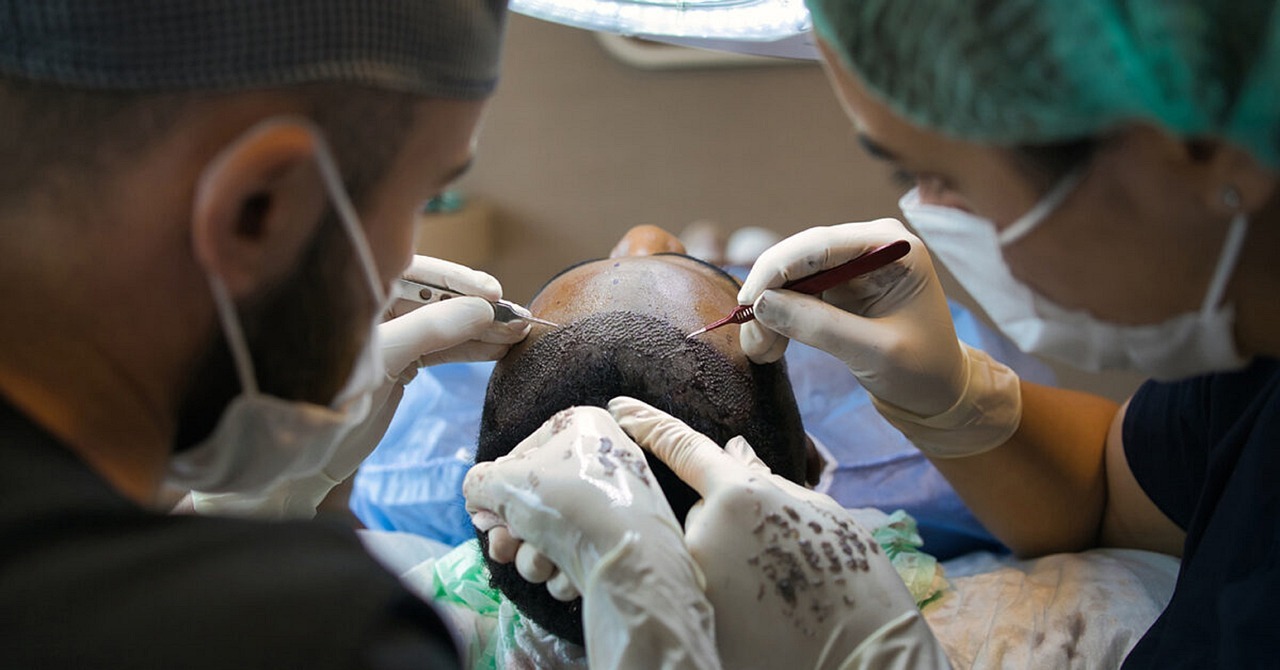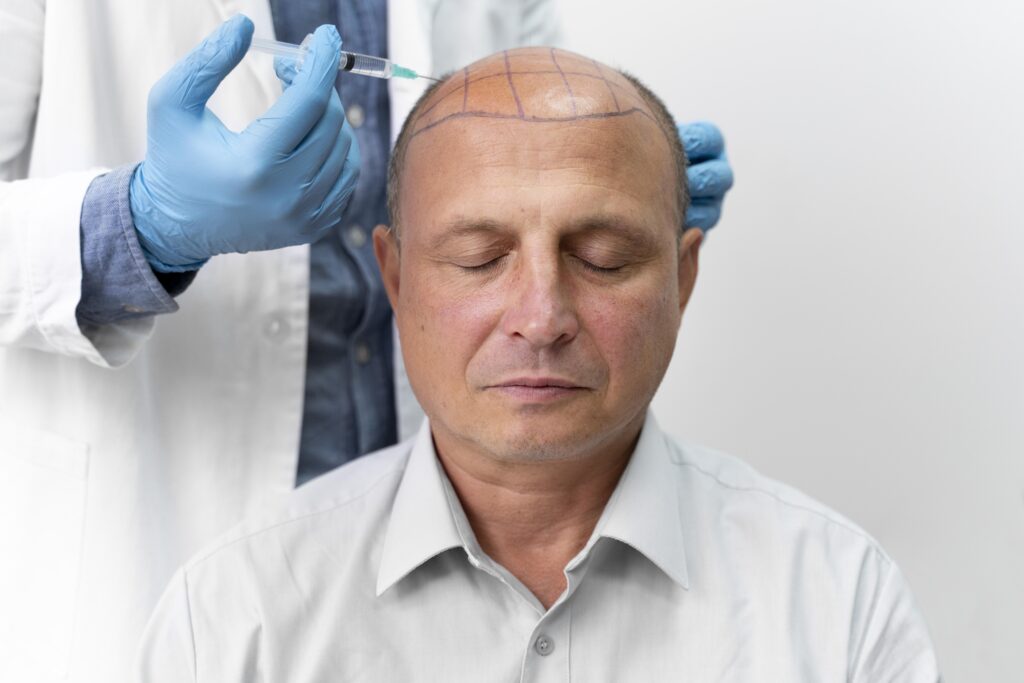What is hair implantation & How is it carried out

In hair implantation, doctors use needles to move your hair from one place to another on your head. The most common type of hair implantation is known as grafting.
Table of contents
- What is hair implantation?
- What are the different types of hair implantation?
- 1. Grafting
- 2. scalp reduction surgery
- 3. Flap surgery.
- 4. Tissue Expansion
- What is Grafting Hair implantation?
- What happens during a hair implantation surgery?
- Follicular unit transplantation (FUT):
- Follicular unit extraction (FUE)
- What are the complications of hair Implantation?
- What are the Concerns regarding Hair Implantation
- Take Away
- HairFortin – Advanced Hair Growth Formula
What is hair implantation?
A hair transplant is an option to address bald spots or permanently thinning areas on the scalp. Therefore, you will need thicker hair in certain areas for the surgery to be successful. Various factors can contribute to permanent hair loss, including aging, a child’s birth, and menopause.
After an hour long surgery, hair is usually transplanted from the back or side of the head to the front or top of the head. This typically occurs in a doctor’s office and is completed under local anesthesia.
Pattern baldness is to blame for more than 90% of hair loss. This is explained by genetics. In the minority of cases, other factors including:
- diet
- stress
- illness
- hormonal imbalance
- medications
What are the different types of hair implantation?
There are a few ways to perform hair implantation surgery, including:
- Grafting.
- Scalp reduction.
- Flap surgery.
- Tissue expansion.
1. Grafting
One of the two types of hair implantation is a slit graft. In this procedure, the healthcare provider will use a small circular punch to take hair from the donor area and replace it on the patient. Also, doctors make small slits on the scalp to remove your healthy hair.
2. scalp reduction surgery
Scalp surgery like FUE is a type of treatment for hair loss that may be more popular in men, however, does have female applications too. The procedure, among other things, involves moving the skin on your scalp that has hair to cover bald areas. For example, skin from the sides of your head might be pulled up and stitched together if the top of your head is bald.
3. Flap surgery.
Flap surgery is a reconstructive procedure, often used in areas affected by trauma or burns. Healthy tissue is surgically transferred from one part of the body to another to restore what has been lost elsewhere.
4. Tissue Expansion
Tissue Expansion is a procedure that can restore lost or damaged skin by promoting new growth of healthy skin cells that can be used in cosmetic procedures. Also, this reconstructive procedure is available for most areas of the body, meaning plastic surgeons can repair any skin damage caused by in born or acquired defects.
What is Grafting Hair implantation?
Hair implantation surgery is one of the most popular hairs restoration options. In addition, out of all the different natural hair restoration methods, micrografts is one of the most popular.
A specialist will not just take 10-15 hairs from your scalp but will instead remove very tiny pieces containing a higher number of follicles that are healthy and in good condition.
A surgical hair transplant can take more than a couple of hours. But, there will be medicine to relax your scalp and general anesthetic should you need it.
The typical patient stays awake for the procedure, but some do have the option to go under. You’ll need more than one procedure depending on how much hair your provider needs to move. Your scalp will have to heal for a few months in between the hair implantation procedures.
What happens during a hair implantation surgery?
After thoroughly cleaning your scalp, a surgeon will place an injection of local anesthesia to numb the area before hair implantation surgery

There are two main techniques for obtaining hair follicles during a transplant: FUT (strip harvesting) and FUE (direct extraction).
Follicular unit transplantation (FUT):
- The surgeon will make a section of scalp skin on the back of your head that’s typically several inches long.
- For the wound to heal, you need to sew it up.
- You might consider hair implants that provide a natural-looking hairline. They are sometimes separated into small pieces with a magnifying lens and sharp surgical knife before being implanted.
Follicular unit extraction (FUE)
In traditional hair transplant surgery, human hair follicles are taken from the back of the head and surgically implanted in the areas where they are needed.
- The medical professional performs a process – called Follicular Unit Transplantation – that involves cutting into the scalp with needles or blades and inserting individual hair grafts.
- During a single hair transplant session, one surgeon may use hundreds or even thousands of hairs
- After, the grafts, gauzes, or bandages will cover your scalp for a few days
Most hair implantation sessions will take between 4 hours and more. Additionally, they remove the stitches about 10 days after surgery.
It typically takes three to four sessions to gain the desired amount of hair. The interval between each session is six months so that each hair implantation can heal properly.
While the hair implantation is lost typically within 2-3 weeks, most patients see the new hair grow after 8-12 months.
What are the complications of hair Implantation?
Hair implantation side effects are not serious and typically clear up within a few weeks.
They can include:
- bleeding and swelling of the scalp
- itching and infection
- bruising around the eyes
- a crust or scab that forms on the places where hair removal or implantation was there.
- There may be a need to apply the treatment on some areas of the scalp more than once. Also, numbness or lack of sensation around the treated area may persist for a few hours after the hair implantation treatment.
- Cause of a rash on the scalp is by an inflammation of the hair follicles, which is “folliculitis.”
- Shock loss or sudden hair loss is temporary and typically normal after a transplant.
- un natural looking tufts of hair
What are the Concerns regarding Hair Implantation

Hair implantation is a painless procedure. Doctor will numb you with a local anesthetic, so you should not feel any pain at all.”
However, as with most surgical procedures, you may experience some pain or discomfort at the incision points as your body starts to heal.
For people who don’t find success in therapies, hair implantation can be a good option. For some, it may not provide the desired results, though.
Take Away
You might want to think about what is a hair implantation if nothing else has worked for your hair. There are many techniques and you probably need to have a consultation with a doctor to determine which one would be best for you. Moreover, It’s always best to work with a healthcare provider who will help you find the procedure that best suits your personal goals. Look for someone with experience in both hair loss and hair restoration procedures.
Products That We Suggest for you
Folisin – Natural Hair Growth & Support testosterone levels
Support natural hair growth. Also, Reduce the intensity of hair loss. Help maintain normal hair pigmentation. Support keeping proper testosterone levels.
To know more and purchase, Click Here
HairFortin – Advanced Hair Growth Formula
HairFortin is a strong hair growth solution that promotes healthy hair growth and naturally prevents hair loss. It is completely safe to use and has confirmation in clinical studies.
To know more and purchase, Click Here








Comment to this Article
Comments that encourage respectful conversation are welcomed at AGP Health n Beauty. Stay on subject, please. Comments that are aggressively promotional of goods or services or that include personal attacks, vulgar language, or other forms of abuse will be deleted. Which remarks break our comment policy will be decided at our discretion. (Anonymous comments are accepted; just leave out your name in the comment box. Although necessary, your email address won't be posted with your comment.)